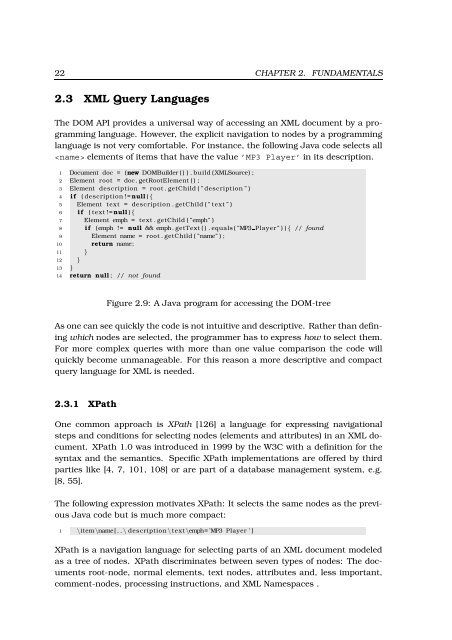url - Universität zu Lübeck
url - Universität zu Lübeck
url - Universität zu Lübeck
You also want an ePaper? Increase the reach of your titles
YUMPU automatically turns print PDFs into web optimized ePapers that Google loves.
22 CHAPTER 2. FUNDAMENTALS<br />
2.3 XML Query Languages<br />
The DOM API provides a universal way of accessing an XML document by a programming<br />
language. However, the explicit navigation to nodes by a programming<br />
language is not very comfortable. For instance, the following Java code selects all<br />
elements of items that have the value ’MP3 Player’ in its description.<br />
1 Document doc = (new DOMBuilder ( ) ) . build (XMLSource) ;<br />
2 Element root = doc . getRootElement ( ) ;<br />
3 Element description = root . getChild ( ” description ” )<br />
4 i f ( description != null ) {<br />
5 Element text = description . getChild ( ” text ” )<br />
6 i f ( text != null ) {<br />
7 Element emph = text . getChild ( ”emph” )<br />
8 i f (emph != null && emph. getText ( ) . equals ( ”MP3 Player ” ) ) { // found<br />
9 Element name = root . getChild ( ”name” ) ;<br />
10 return name;<br />
11 }<br />
12 }<br />
13 }<br />
14 return null ; // not found<br />
Figure 2.9: A Java program for accessing the DOM-tree<br />
As one can see quickly the code is not intuitive and descriptive. Rather than defining<br />
which nodes are selected, the programmer has to express how to select them.<br />
For more complex queries with more than one value comparison the code will<br />
quickly become unmanageable. For this reason a more descriptive and compact<br />
query language for XML is needed.<br />
2.3.1 XPath<br />
One common approach is XPath [126] a language for expressing navigational<br />
steps and conditions for selecting nodes (elements and attributes) in an XML document.<br />
XPath 1.0 was introduced in 1999 by the W3C with a definition for the<br />
syntax and the semantics. Specific XPath implementations are offered by third<br />
parties like [4, 7, 101, 108] or are part of a database management system, e.g.<br />
[8, 55].<br />
The following expression motivates XPath: It selects the same nodes as the previous<br />
Java code but is much more compact:<br />
1 \item\name[ . . \ description \ text \emph= ’MP3 Player ’ ]<br />
XPath is a navigation language for selecting parts of an XML document modeled<br />
as a tree of nodes. XPath discriminates between seven types of nodes: The documents<br />
root-node, normal elements, text nodes, attributes and, less important,<br />
comment-nodes, processing instructions, and XML Namespaces .
















